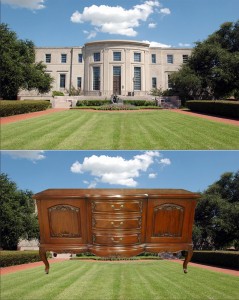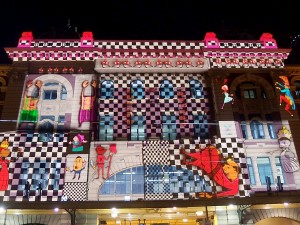By Derham Groves, Ph.D., University of Melbourne, Australia
Looking at the Armstrong Browning Library and Museum (ABL&M) from the street, the front façade resembles a Georgian-era bow-fronted sideboard, which is in keeping with the building’s overall function as a container for the Browning collection or, more specifically, a Browning cabinet of curiosities.
However, having read the correspondence between Dr. Armstrong and the two architects who separately were responsible for the design of the building, Wyatt C. Hedrick and Otto R. Eggers, and also having bummed around the ABL&M myself as a visiting scholar in December 2014 and January 2015, it was very clear to me that, architecturally speaking, Hedrick’s design of the exterior of the building fell short of Egger’s interiors and the marvelous Browning treasures housed inside the building.
While this was by no means the original intention of either the client or the architect, the ABL&M building’s rather dull exterior is very easily explained. Firstly, so much money had been spent on the interior that savings had to be made on the exterior.
Secondly, by the end of the long-drawn-out design and construction process, the relationship between Armstrong and Hedrick had deteriorated to such an extent that, putting myself in the architect’s shoes, I would have just wanted to finish the job as quickly as possible and move on to the next one.
Being an architect myself, my inclination was to put things right—albeit decades after the building’s completion. Inspired by the Baylor University community’s enthusiasm for lighting up the Christmas tree in December 2014, I wanted to likewise light up the ABL&M building.
In Melbourne, Australia, where I live, the ‘White Night Festival’ is held for one night only in February each year. On this occasion, many downtown buildings are magically transformed by projecting colours, images and patterns onto their facades. The same thing could very easily happen at the ABL&M.
So I asked the 110 Master of Architecture students who did my history and theory course, Popular Architecture and Design, at the University of Melbourne in semester two 2015 to design some light projections specifically for the front façade of the ABL&M.
The students focused on mainly four themes: (1) the idea that the ABL&M is a Browning cabinet of curiosities; (2) Robert Browning and Elizabeth Barrett’s love story; (3) the works of Robert Browning, in particular ‘The Pied Piper of Hamlin’ and ‘The Ring and the Book’; and (4) the influence of Dr. Armstrong. Following is a very small sample of their work.
- Design by Lucy Brommeyer
- Design by Hoa Yang
- Design by Rong Chen
- Design by Adrian Beltran
- Design by Weichao Ran
- Design by Ellie Bai
- Design by Lucy Griffith
- Design by Li Siqi
- Design by Siyu Lei
- Design by Queenie Chiu
- Design by Rikky Falantino
- Design by Chee Heng Tan
- Design by Caroline Marten
- Design by Dylan Kelleher
- Design by Jessica Finch
- Design by Florens Todesco
- Design by Lim Cheong Shien
- Design by Yin Chang
- Design by Chau Hei Tong
- Design by Jean Alexandre Law Min
- Design by Minyu Liao
- Design by Jaxsun Plumley
- Design by Po Yee Ho
- Design by Lawrence Rocha




























